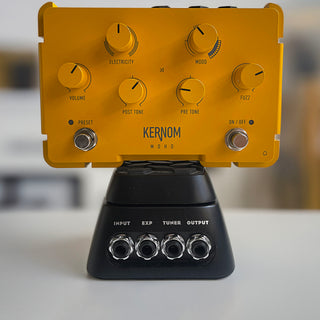Have you ever dreamed of controlling your overdrive pedal or fuzz pedal with a simple move from your foot ? To go from a soft fuzz tone to a devastating lead sound ? To have all the subtleties in between ? Take the control of your RIDGE overdrive and MOHO fuzz with an expression pedal and make this possible.

Plug your expression pedal, and morph your sound !
Adding an expression pedal to your RIDGE or MOHO allows you to morph your sound into another, and to get access to all the nuances between both. It’s the best way to tap the full potential of your pedal. Plug your favorite expression pedal (Mission Engineering EP-1, Dunlop DVP or BOSS FV500 are great options) with a regular stereo cable in the dedicated input and here we are, nothing more to do ! In the base mode, the expression pedal will get you from the direct sound (the setting indicated by the knobs position) when the pedal is set on “heel position”. When you engage the pedal and go to “toe position”, you will get the sound of the internal preset. Using an expression pedal is like having six hands turning the knobs at the same time, from a position to another. This way, you can reach an infinity of variations between both sounds, instead of just switching between them.
Whether you’re in the studio, on stage, or at home, adding an expression pedal to your overdrive pedal (or fuzz pedal) is a boost for your creativity. You can modulate your sound depending on the musical situation. You can also get a huge range of tones without having a plethora of presets, and the most important : being inspired. In my opinion, it’s a great way to adjust my tone depending on what happens, and to 100% feel the music. Usually, I set up the direct sound of my overdrive pedal like a clean boost, and the preset with a heavy distortion. This way, I can rely on the expression pedal to find a tone that always suit my needs. A cool rhythm section ? I roll back the expression pedal. Solo time ? I push it and get the sound.
Now you can experiment with your beloved analog overdrive pedal (or analog fuzz pedal) to get new sounds, new ways to use it thanks to the expression pedal. There’s nothing to set or calibrate. You don’t waste time setting some parameters. It’s really plug ‘n play !

New ways of morphing with the RIDGE and MOHO
Morphing between two sounds isn’t the only option you have. You can choose to only act on one of the six knobs. For example, set your tone with the DRIVE knob set at the minimum. Save the exact same setting in the internal preset but with the DRIVE knob at the maximum position. Here, nothing will morph except your DRIVE level. It’s a good way to control your tone along a song, and add more heaviness whenever you want.
This function allows you to use your RIDGE or MOHO in various ways :
- act on the VOLUME knob and change the dynamic of your amp
- act on the MOOD knob and change the kind of overdrive (or fuzz) you hear
These are just examples, and we didn’t even talk about the EQ section of your pedals. You can totally act on the POST TONE and tailor the tone, for example. In my case, I like to assign the expression pedal to the DRIVE knob. I can play my favorite riffs, push the gain for a solo, or roll it back if the song softens.
Assign your expression pedal to your favorite presets
The RIDGE and the MOHO being a MIDI overdrive and MIDI fuzz respectively, you can also assign your favorite presets to the “heel/toe” position of the pedal and again, take advantage of what we previously saw. Plug your expression pedal into the dedicated input of your RIDGE (or MOHO) and follow these steps :
- press and hold both footswitches, both LEDs should light up in orange
- to set the “heel” position setting, press and hold the PRESET footswitch. The LED should start to blink
- send a Program Change matching the preset you want to hear when the expression pedal is set on the “heel” position
- press and hold both footswitches to save the “heel” position. The PRESET LED should blink fast while the ON/OFF LED should remains lighted up in orange
- At this stage, both LEDs should be lighted up in orange, no blinking
- to set the “toe” position setting, press and hold the ON/OFF footswitch. The LED should start to blink
- send a Program Change matching the preset you want to hear when the expression pedal is set on the “toe” position
- press and hold both footswitches to save the “toe” position. The ON/OFF LED should blink fast while the PRESET LED should remains lighted up in orange
- At this stage, both LEDs should be orange and not blinking. Press and hold both footswitches again. They should blink quickly and turn off. You’re done !
What’s next ?
Whether you want to morph your sound, find new nuances or control only one knob, the expression pedal covers all your needs. There’s not only one good way to use it. The best advice I can give you is to use the expression pedal the way you want, the way you need it. The RIDGE and the MOHO are very versatile pedals that will meet your needs and your use. Let your creativity go, explore new sonic territories and see where it leads you. I strongly encourage you to try this function to get new sounds from your overdrive pedal or fuzz pedal. Don’t hesitate to share your videos and to tag us.
Subscribe to our newsletter so you don’t miss the next articles ! In the next post, we’ll talk about
the PRE TONE of the RIDGE overdrive ! See you soon !

by Anthony Barbier
Anthony is the person behind Kernom social media. If you’re searching for him, he will probably with a guitar in his hands, trying to find new sounds or behind his keyboard writing posts about our pedals.
